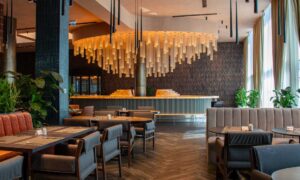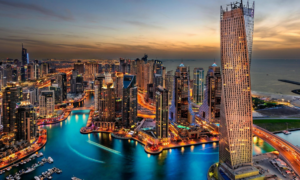Feel like home and experience rich, flavourful and an eclectic variety of cuisine in an ultra-premium vibe
The swanky new Indian Resto Lounge has opened at Majestic City Retreat Hotel in Mankhool Dubai and represents some of India’s quirky, multifarious cultures trending today as a pop-lifestyle phenomenon with its extremely diverse centuries-old culinary heritage. The cuisine promises a varied sumptuous mouth-watering experience from the coastal cuisine traditions across the southern belt in India while bringing back Bar Baar’s signature Indian delights to town.
Sustainable, eco-friendly, and seasoning using only homegrown herbs, The Permit Room boasts an unmistakable familiarity that feels like home in the familiar setting of a pub. Because, who said you can’t enjoy your favorite Idli-Sambhar or Chettinad Chicken with a creative mixed drink? The venue offers a premium dining experience with exceptional service, unique culinary creations, and an exclusive atmosphere of an inhouse resident DJ belting out some Indo fusion music and a two-piece band performing on contemporary sound.
The average price at The Permit Room is economical and affordable in comparison to the local market. Apart from dine in, it also conveniently caters to delivery service. It spans over 4000 square feet, seats up to 175 guests and offers both indoor and outdoor dining experiences as well as an expansive outdoor terrace to enjoy Shisha. It’s pet friendly too!
Mr. Hiren Sarvaiya, Managing Director said, “The long-term goal is to establish a strong reputation for high-quality food and beverages, exceptional service, and a unique and memorable dining experience that sets The Permit Room apart from the competition and builds a loyal customer base.”
“The Permit Room staff have excellent communication and interpersonal skills, as well as a commitment to providing exceptional service to customers by providing profound knowledge about the menu and be able to make recommendations to customers based on their preferences.”
The coastal region of India, which includes states like Kerala, Goa, Andhra, Karnataka, and Tamil Nadu, has a rich culinary heritage. The cuisine of the coastal region is influenced by the local geography, climate, and culture, and is known for its unique flavors, spices, and ingredients. Seafood and non-Veg food is a major component of the The Permit Room cuisine, as it is easily available and fresh. Fish, prawns, crabs, and other varieties of seafood are cooked using different techniques and spices to create a wide range of dishes. Some of the popular seafood dishes include fish curry, prawn fry, crab masala, and lobster biryani.
Coconut is another staple ingredient in the The Permit Room cuisine, used in various forms, including grated coconut, coconut milk, and coconut oil. It is used to prepare curries, chutneys, and desserts, adding a unique flavor and texture to the dishes. Rice is the main staple in the coastal region, and it is served with a variety of curries and side dishes. The use of local spices and herbs, such as coriander, cumin, turmeric, and curry leaves, gives the The Permit Room cuisine a unique flavor and aroma. Tamarind and kokum are also commonly used to add sourness to the dishes, while chillies, both fresh and dried, are used to add heat and spiciness.
The Permit Room cuisine also includes vegetarian dishes made using local vegetables, lentils, and legumes. Some of the popular vegetarian dishes include avial, sambar, rasam, and thoran.
The interior design and decor of The Permit Room takes cue on the old British India era: through the colorful use of wood and rattan infused with pop-culture through retro hand-drawn posters, layered on the wall of the dining caverns. It is a fusion of vibrant colors, patterns and decor celebrating the richness of Indian Food and Culture. Indoor dining includes arched windows allowing guests to have a more intimate dining experience. The outdoor takes inspiration from the rich culture of Gond art, with deep brown and ochre serving as the primarily colour palettes for the space. Sustainability is a key pillar of the brand’s design and architecture, installations, sculptures, and even furniture and lighting have creative applications of the materials.



























